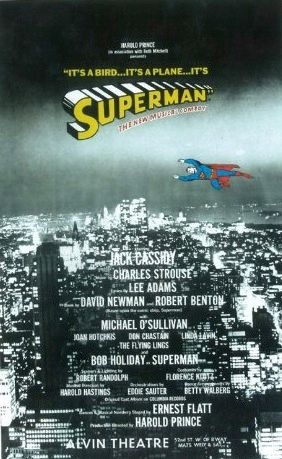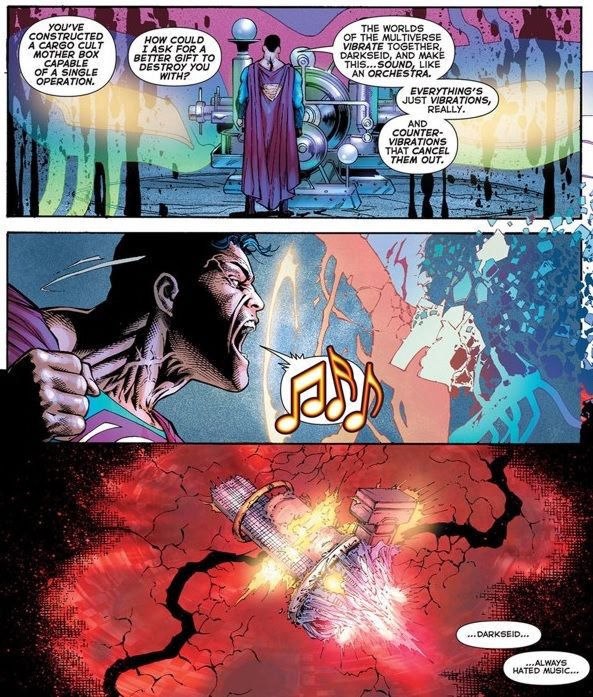In 2008-09, Grant Morrison wrote (and J.G. Jones and others drew) DC Comics' big-event miniseries Final Crisis. While it wasn’t the last cosmic-minded crossover, in many ways it was the crest of a wave that had been building since 2004's Identity Crisis. The fallout from Identity Crisis sparked a new “Crisis Cycle,” leading into 2005-06's Infinite Crisis, 2006-07's 52, 2007-08's Countdown, and various smaller-scale tie-ins.
With Morrison at the helm, though, Final Crisis turned out to be pretty esoteric. Apparently this pleased almost no one, being a) too steeped in DC lore for the casual reader, and b) not sufficiently tied into the regular comics, and thereby not rewarding the every-Wednesday folks who’d been following all the buildup.
Nevertheless, two FC plot points had immediate effects on the superhero line that, for all intents and purposes, have carried over into the New 52: It brought back Barry Allen and “killed” Batman. I was reminded of the latter two weeks ago, when a one-panel flashback in Robin Rises: Omega indicated pretty strongly that Darkseid’s Omega Effect (coincidence?) sent the New 52's Caped Crusader bouncing through the time stream, just like his continuity-complicated predecessor. Accordingly, like so many DC stories of yore, Final Crisis still seems to have happened, even if in a significantly altered form.
Before we get too much further, rest assured this post isn't dedicated to figuring out how a Final Crisis-shaped peg fits into a one-panel Robin Rising hole. Instead, I want to talk about how another FC plot point is helping to alter my perceptions of continuity.
* * *
Approaches to continuity, by both readers and storytellers, exist on a continuum. At one end is a very big-picture view that sees every issue of every series as another installment in the ongoing story of that universe. Opposite that is the view that every story stands on its own, and continuity between stories (and among series) is just a bonus. The story-specific approach was typical of superhero comics from the late ‘30s through the early ‘60s, because writers and editors figured their readership didn’t care about such things -- partly because they didn’t stick around long enough.
Naturally, that changed in the early ‘60s, when Marvel’s characters began interacting with (and talking about) each other in the same fictionalized New York City. Ironically, Marvel’s brain trust was inspired to create Fantastic Four by the DC book that brought together its big names, Justice League of America. However, DC’s writers and editors didn’t exploit character connections to anywhere near the degree that Marvel did.
What writer Gardner Fox and editor Julius Schwartz did do was find a way to incorporate all of DC’s older stories and characters into its current superhero books. “Flash of Two Worlds” (penciled by Carmine Infantino and inked by Joe Giella for September 1961's The Flash #123) codified the concept of parallel Earths, and specifically the idea of an Earth-Two where readers could revisit DC’s original array of characters. Subsequent stories used different Earths to introduce new-to-DC characters (like the Marvel Family of Earth-S), and fans assigned “Imaginary Stories” and otherwise hard-to-reconcile tales to their own alternate universes. It was an infinite Multiverse, after all.
On one level it’s only semantics that divide one set of fictional stories from another. However, the implications of a Multiverse -- where, for example, the unmarried Earth-One Superman could ask the Earth-Two Supes and Lois Lane about decades of wedded bliss -- got to be too much. More to the point, if every story mattered, then every story also contributed to the “rules” of the shared universe. Thus, although the Multiverse gave all those characters good homes, it also reinforced a potentially infinite set of jurisdictions, each with its own distinct rules. Better instead to have singular versions of these characters, and make everything work as best it could.
Still, even with a singular DC-Earth, the idea of a multiversal infinitude persisted. In the late ‘90s, Mark Waid and Grant Morrison came up with “Hypertime,” which allowed the singular DC-Earth timeline to interact, however briefly, with an infinite number of alternate timelines. Basically, Hypertime said every story that had been published was still “out there,” somewhere -- but it was just extremely difficult to visit any particular one. Put another way, Hypertime basically said all the stories you liked never really went away, and never mind the in-universe reasons.
Hypertime never caught on, but before long DC was back in the Multiverse business, again thanks in part to Waid and Morrison. They (along with co-writers Greg Rucka and Geoff Johns) introduced the 52-universe “Orrery” at the conclusion of 52. This Multiverse looked a good bit like the old one, with Earths dominated by the Justice Society, Marvel Family and ex-Charlton characters, as well as Earths for the more popular “Elseworlds” imaginary stories. That was the Multiverse at risk in Countdown and Final Crisis; and for the most part that’s the Multiverse of the upcoming Multiversity.
* * *
I tell you all of that to say this: It’s easy to get caught up in the rules. Reading an old-school Earth-Two book like All Star Squadron or Infinity, Inc. can be like an NFL fan trying to watch Canadian football. It’s hard to get past the differences and just enjoy the game. However, for the past 50-plus years, superhero serials have focused (consciously or not) on their particular sets of rules.
This is perfectly understandable. Many of those rules are intended to help immerse the reader in the story. It can be reassuring to know that a character exists, and progresses, within recognizable boundaries. I’m not anti-continuity by any means -- I get a huge kick out of stories like Marvels or Green Lantern: Rebirth that are built on pre-existing points in continuity. Indeed, when I see something incongruous -- like Final Crisis in Robin Rises -- I want to try to make sense of it. The inherent fantastic nature of superhero comics virtually demands some underlying logic, even if it’s a logic specific to the setting.
Nevertheless, sometimes that rational demand must bow to a plot point’s emotional effect. Including Batman’s Final Crisis “death” in Robin Rises reminded readers of the larger Bat-saga simply and efficiently. A more vague allusion to Bruce Wayne “going away” might itself have been distracting, calling attention to a potential untold story instead of keeping the focus on the current one. What’s important for Robin Rises is Bruce’s absence, and the distance it put between him and his son at a crucial time.
The tension between rules-based continuity and a more free-form approach reminds me of the various metaphors used to describe the Holy Trinity. Some Christians compare the different aspects of Father, Son and Holy Spirit to the human soul, body and spirit; the three states of water (liquid, solid, gas); or the three parts of an egg (shell, white, yolk). Others think of God as wearing different hats, or fulfilling different roles (friend, parent, spouse). It’s difficult to conceptualize. Recently, however, I heard a new metaphor, attributed to theologian Jeremy Begbie: three notes in a musical chord. Each note stands on its own, and each can be heard when the chord is played, but the chord itself is also a distinct musical expression.
In terms of comic-book continuity -- and please note I don’t intend to compare continuity directly to one of the big mysteries of faith -- I think the older stories are used in much the same complementary fashion. Although not every story is successful, every story stands on its own. When an ostensibly out-of-continuity story gets referenced in a current one, we’re aware of the distinct “voices,” just as we’re aware of the distinct notes within a chord. What matters, both in music and in this sort of narrative, is that the interaction creates the intended emotional response. If the interaction works, you can find a way to rationalize it -- but rationalization isn’t the point.
That’s part of what makes projects like Final Crisis and Multiversity, and all-inclusive structures like the old Multiverse and Hypertime, so appealing. They play more to a story’s emotional resonance than to its precedential value. In Final Crisis, Morrison brought back such obscurities as Anthro, Libra and the Human Flame, and populated Limbo (itself seen previously in the Morrison-written Animal Man) with the characters the rejects had forgotten. Regardless, as he did with Batman’s “Black Casebook,” by spotlighting these old elements, Morrison affirmed the value they once had, and might have again. In their Architecture and Mortality serial, Brian Azzarello and Cliff Chiang arguably went even further, using the 52 writers as the character-rejecting villains of their ode to the Z-listers -- which, come to think of it, included Anthro.
I know this sounds all touchy-feely and holistic, and these things have no place in the cold, logical world of contemporary super-comics. However, remember the end of Final Crisis, when the Forever People’s summoning word “Taaru!” and the corporate chant of the Green Lantern oath were rallying cries for the final battles. Remember also Superman’s final words to his imprisoned foe: “The worlds of the Multiverse vibrate together, Darkseid, and make this ... sound, like an orchestra. Everything’s just frequencies, vibrations.” There are worse ways to imagine the sweep of a fictional history, with all its different cadences, harmonies, and themes.
+++++++++++++++++
And here is the Futures Index for this week’s Issue 13.
- Story pages: 20
- Tim Drake pages: 5 (3-page opening sequence and 2-page “shopping” sequence)
- Terrifitech pages: 3
- Cadmus Island pages: 4
- “Let’s rob Terrifitech” pages: 3
- Barda/Emiko pages: 5
- Possible cover homage: Batman #608
NOTES: I think this is the first issue to let one of its narrative tracks split up another one. That’s kind of refreshing, because FE has been pretty comfortable so far just checking in with particular tracks and then letting them go for another week. I’m glad we didn’t have to wait a week for closure on the whole “is Tim a coward?” thing, is what I’m saying. In fact, I think the two Terrifitech tracks (or at least what I’ve identified as such) are another example of the same thing -- and both were probably written by Brian Azzarello -- although unlike the Tim track they feature different characters. Speaking of which, the HAL-as-sycophant characterization of the proto-Brother Eye was pretty clever.
I’ve also been enjoying the Grifter/Susie back-and-forth, so much so that I was disappointed to see her back with Deathstroke on the final page. If memory serves, Keith Giffen has been writing the Grifter bits, and while the “hunting aliens” sequences have been pretty grim, the Cadmus Island scenes have made up for it.
Finally, if I had to guess, I’d say the demands of the story require Barda to lose to Deathstroke next week. However, I hope Deathstroke’s victory isn’t rooted in his being some super-cool unstoppable assassin dude, because ever since Identity Crisis, Arrow, and all those videogames he’s nudging ever closer to self-parody.
NEXT WEEK IN THE FUTURE: Susie fights twice! Hawkgirl behind bars! Batman Beyond busted! And ... inside Red Tornado!



